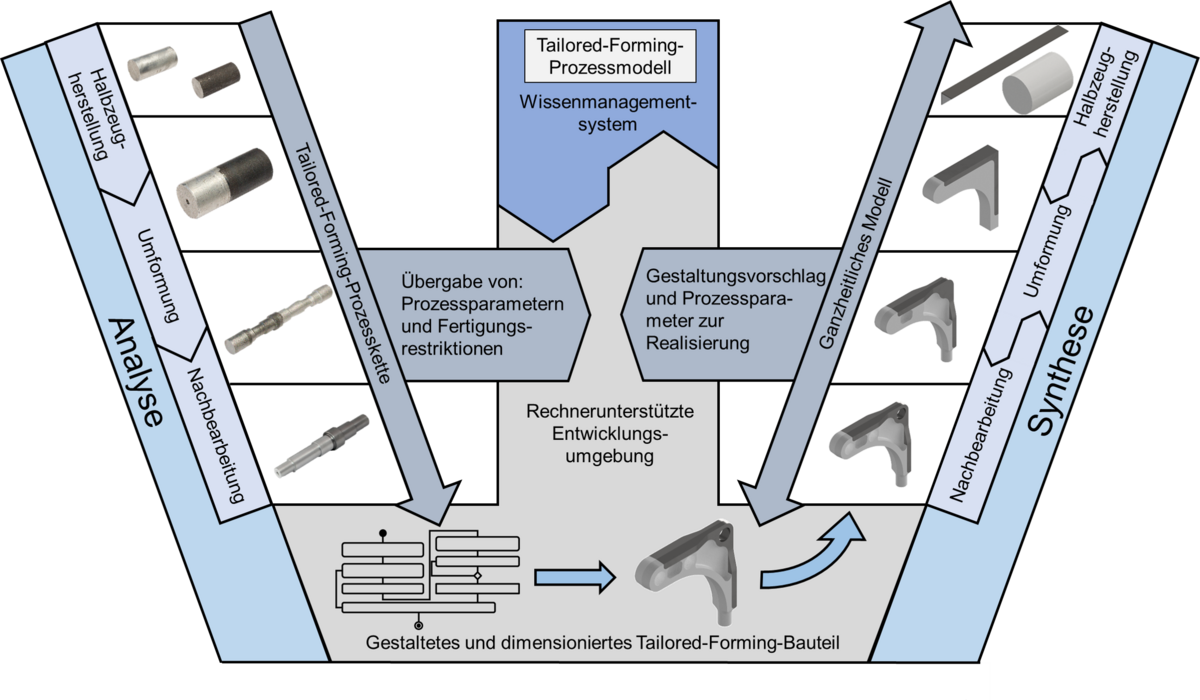Motivation and objectives
The methodological basis for the configuration design of Tailored Forming components is a system approach that considers the interrelationships of the Tailored Forming process chain and takes into account the possibilities and limitations of Tailored Forming technology, aiming for meeting the requirements and quality criteria. The starting point for subproject C02 is the scientific question of how Tailored Forming components must be designed in order to exploit the potential of hybrid components. The goal is to develop methods that, on the one hand, increase the application range of tailored forming components and, on the other, minimize the development effort for the process chain. In order to achieve these goals, it will be investigated in which way geometric and production process-related knowledge can be implemented in the existing development environment so that it can be used to send design information back to the process chain. Thereby, in order to validate the methods, present test benches will be further developed and used.
Results
In the 1st funding period, TRIZ-Reverse was developed as a method for determining the potential of Tailored Forming. TRIZ-Reverse is based on the Theory of Inventive Problem Solving (TRIZ). The method uses the mechanisms of generalized solution principles and contradiction resolution. The potential of the use of different materials in a component compared to a mono-material component was investigated. A knowledge base in the form of a design catalogue has been built up from the collected findings, in which the potentials of various forged components for Tailored Forming applications have been collected and evaluated in a structured manner.
The Interfacial Zone Evolutionary Optimization (IZEO) topology optimization method was developed to determine the material distribution. The method (Figure C2.1) makes it possible to create designs of Tailored Forming components while taking manufacturing restrictions into account.



Design guidelines for the joining zone geometries of friction-welded and extruded shafts have been drawn up by means of parameter studies. Some of the manufacturing possibilities of the process chain and the results obtained on the developed torsion test bench (Figure C2.2) with manufactured Tailored Forming shafts were considered.



Current work and outlook
In the 2nd funding period, work is being carried out on the implementation of IZEO for non-symmetrical Tailored Forming components, which will be used to design the material distribution in a suspension arm demonstrator. To validate the simulation models, a multiaxial load test bench will be put into operation (Figure C2.3).



In addition, the individual production stages of the Tailored Forming process chain are considered. Various transfer models are set up with which the geometry of the individual production stages can be determined on the basis of the final component geometry (Figure C2.4). To that purpose, the analysis of a tailored forming part can be used to draw conclusions about the synthesis of other parts. This makes it possible to identify at an early design stage whether a component can be produced with the available means or not. At last, the geometries of the forming tools required for production can be automatically derived from the models.



Publications
Subproject leader


30823 Garbsen


30823 Garbsen


30823 Garbsen


30823 Garbsen
Staff


30823 Garbsen


30823 Garbsen


